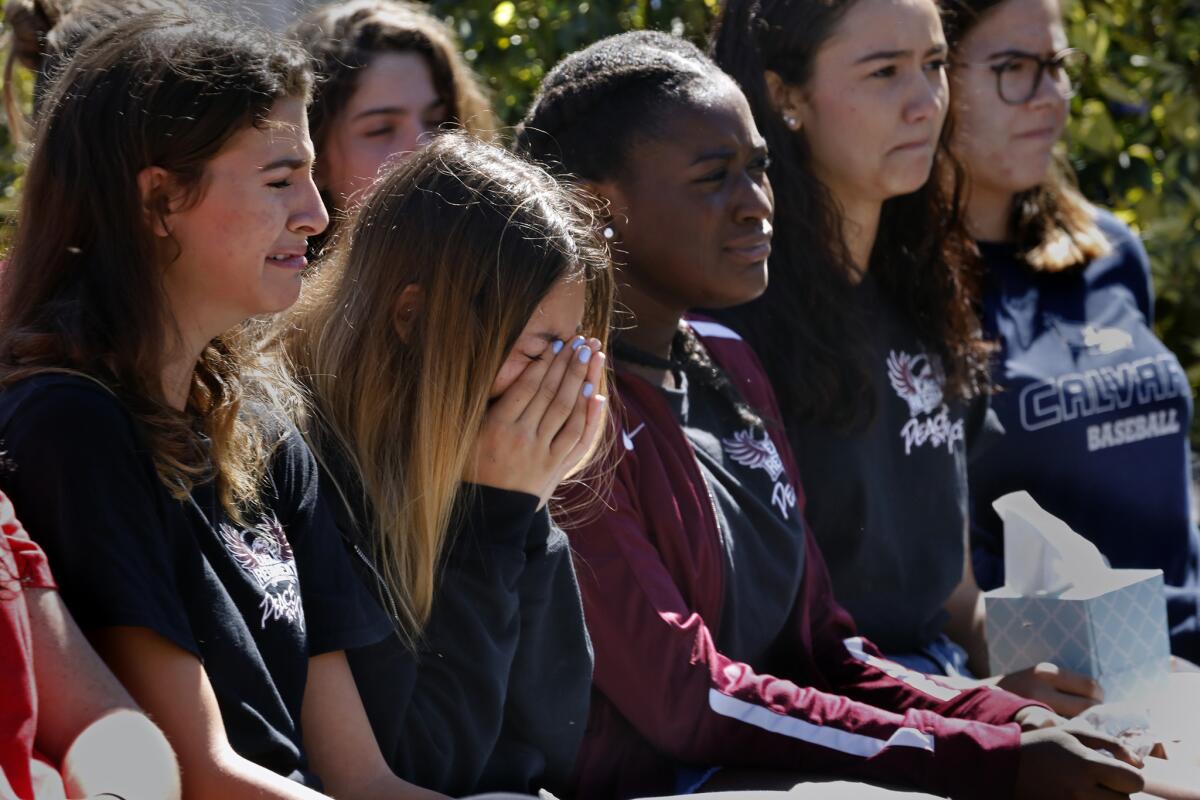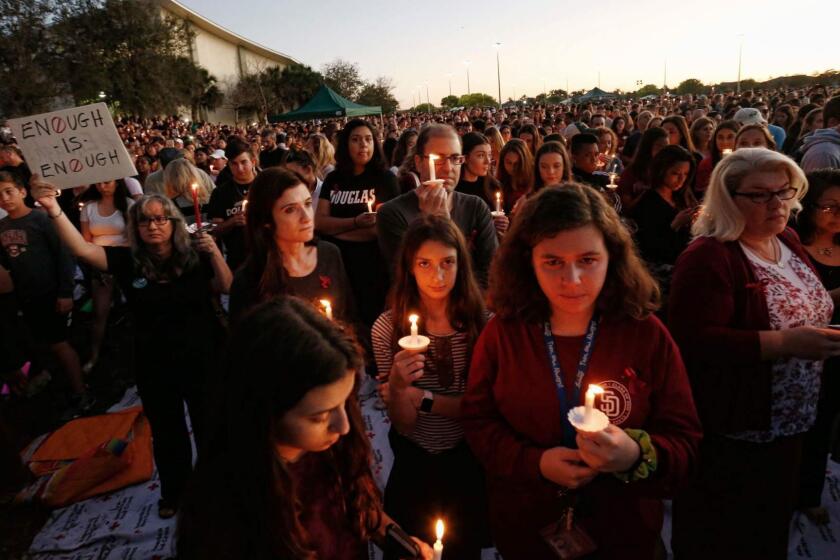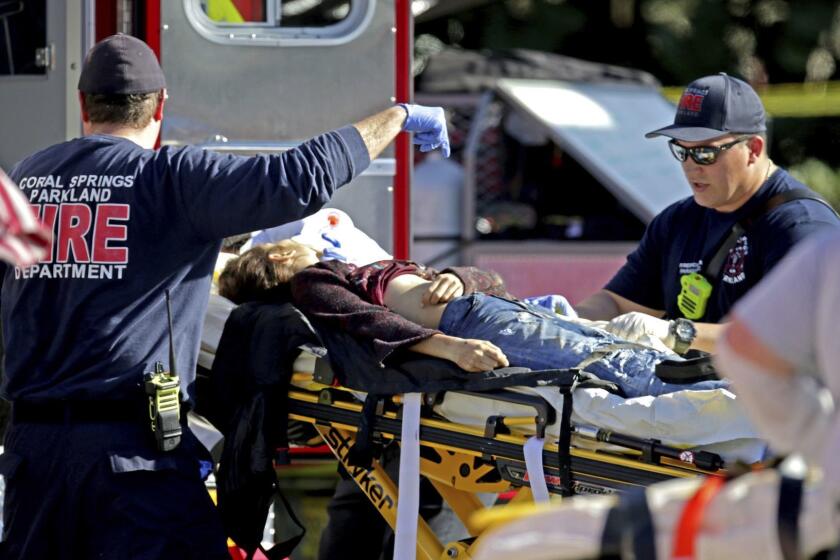After fatal school shootings, antidepressant use surges among student survivors

- Share via
The children who experience a school shooting but live to see their parents and friends again are often called survivors. But by at least one measure of mental health, they too are among a gunman’s victims, new research finds.
In the two years after a fatal school shooting, the rate at which antidepressants were prescribed to children and teens rose by 21% within a tight ring around the affected school.
The increase in antidepressants prescribed to kids grew more — nearly 25% — three years after a school shooting, suggesting that survivors’ depression lingers long after the incident has begun to fade from a community’s memory.
This first-ever effort to measure the mental health consequences of school shootings in the U.S. was reported Monday in a working paper published by the National Bureau for Economic Research in Cambridge, Mass. School shootings reached an all-time high of 17 in 2018, and as the number of incidents has mounted, so too has the number of students directly affected by them.
Since the April 1999 shooting at Columbine High School in Colorado, a person wielding a gun has opened fire on school grounds during the school day no fewer than 234 times. More than 240,000 students attending those primary and secondary schools at the time of these incidents came away with no physical injuries.
Psychological injuries are another matter. In March, for instance, two students who survived the 2018 massacre at Marjory Stoneman Douglas High School in Parkland, Fla., took their own lives.
After three suicides in 10 days involving people directly affected by school shootings, there’s renewed interest in a condition that psychologists call “complicated grief.”
“School shootings represent a tiny fraction of gun deaths in America,” said Stanford University health economist Maya Rossin-Slater, the paper’s lead author. “But they are uniquely potentially traumatizing, and may have these much larger indirect costs — depression, delayed grief, kids not able to move on and be successful in their lives.”
Parents, teachers and those who tend to the health of children need better guidance on which students may need the most support after a school shooting, and for how long, she said.
In a bid to capture how a community’s mental health is affected by gunfire at school, Rossin-Slater and a team of fellow economists from Stanford and Northwestern University focused on 44 school shootings that occurred between January 2008 and April 2013.
In 10 of the incidents, no one was killed or injured; when there were casualties, two or three deaths or injuries was the norm. (The 2012 shooting at Sandy Hook Elementary School in Newtown, Conn., in which 26 were killed and two injured, was by far the most lethal incident included in the study.)
One often-overlooked fact about mass shootings is that they have been very good for the gun business.
To glean whether, where and how school shootings disturbed the mental well-being of survivors, the researchers examined antidepressant prescribing patterns for the two years before and the two years after those incidents. They found that the ripple effects of a school shooting spread well beyond the families and friends of those killed or injured.
The severity of a school shooting greatly influenced the psychological toll on students. In the 15 cases in which there was at least one fatality, antidepressant prescriptions written by healthcare providers near the affected school jumped quickly and continued to rise over 24 months. Within a five-mile radius, post-shooting prescribing to patients younger than 20 rose 21% above levels predicted by pre-shooting prescribing patterns.
After the 29 incidents in which no one died, antidepressant prescriptions to young people rose slightly. But the upward change was not considered significant, the researchers wrote. Statistically speaking, the uptick was more likely explained by prescribing trends already underway rather than by the shooting itself.
Distance mattered too. When the researchers drew rings 10 miles and 15 miles around an affected school, they found no change in antidepressant prescribing to young people, even after a shooting that claimed a life.
In short, the mental health effects of a fatal school shooting can be substantial and long-lasting, even as it is narrowly localized. Students need not have had direct contact with the shooter, or have seen his victims, to suffer lasting trauma, the study findings suggest. But young people who have even a bit of distance on a school shooting incident — experiencing it from the safety of a neighboring school district, for instance — are less likely to suffer a substantial blow.
The number of antidepressant prescriptions written in a given area is far from an exhaustive measure of depression rates there: On average, just a little more than a quarter of depressed adolescents get medication for their condition. But a post-shooting increase in prescribing would probably be a meaningful signal of a community’s change in mental health, the researchers reasoned. And the number of people prescribed an antidepressant offers at least a lower bound on the true depression rate.
“They’re really looking at the tip of the iceberg,” said Columbia University psychiatrist Dr. Mark Olfson, an expert on child mental health and its treatment. “This isn’t the whole picture. But it really draws attention to the impact of being exposed to these shootings. These results are compelling.”
A new report from the Centers for Disease Control and Prevention confirms what too many students across the country already know: The incidence of mass homicides on school campuses has risen steeply in recent years, as has their toll.
The uptick in antidepressant prescribing was least evident when a school shooting occurred in an area with many social workers and psychologists but few child psychiatrists — the principal prescribers of antidepressants. Rossin-Slater reckons that in such areas, the caseloads of psychologists and social workers would be a better gauge of rising depression rates.
Another key finding: School shootings appear more likely to upend the mental health of a community’s children than to disturb the emotional well-being of adults. While antidepressant prescriptions to young people rose near schools where a fatal shooting took place, there was no corresponding hike in antidepressant prescribing to adults.
That suggests that the uptick in antidepressant prescribing for children is not simply the result of doctors’ heightened sensitivity to mental health problems: If it were, an uptick would probably be seen in an area’s adults too. Instead, Rossin-Slater said, the rise in antidepressant prescribing to kids and young adults reflects a genuine deterioration of mental health that is unique to students in or nearby the affected school.
The study suggests that some of the ways schools cope with student suicides might prove useful in the aftermath of a school shooting, Olfson said. Although suicides are rarely as public as school shootings, both events seem to set off a contagion of deteriorating mental health among students.
“I do think there are lessons to be learned here,” he said. “The traditional approach is a passive model: survivors only get help if they seek it. Increasingly, what many schools are doing is to try to turn that around so care is made readily accessible whether a student seeks it or not.”









